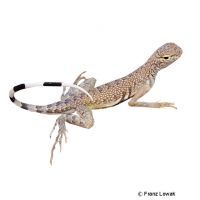Zebra-tailed Lizard (Callisaurus draconoides)
| Zebra-tailed Lizard Callisaurus draconoides | |
|---|---|
| Name | Zebra-tailed Lizard |
| Name Lat. | Callisaurus draconoides |
| Family | Phrynosomatid Lizards |
| Family lat. | Phrynosomatidae |
| Order | Scaled Reptiles |
| Order lat. | Squamata |
| Origin | North America |
| Habitat | Dry savanna, desert |
| Diet | Insects, veggies |
| Humidity | 30-50 % |
| Behavior | ♂ territorial |
| Keeping | Individual, pair, harem |
| Care Level | Moderate |
| Reproduction | Oviparous |
| Housing | Dry terrarium |
| Life Span | 3-5 years |
| Protection | No |
| Metric Units | |
| Size | 22 cm |
| Temperature | 25-30 °C |
| Temperature Local | 45-50 °C |
| Housing Size | 100 x 50 x 50 cm |
| US Units | |
| Size | 9" |
| Temperature | 77-86 °F |
| Temperature Local | 113-122 °F |
| Housing Size | 40" x 20" x 20" |
Distribution and habitat
The range of diurnal, ground-dwelling zebra-tailed iguanas is in the southwestern United States and northwestern Mexico, where they live in rocky deserts and dry savannas with sparse scrub and sandy soils.
Maintenance
Minimum dimensions for the terrarium, according to the size and number of animals
| 1-2 animals | 6KRL x 4KRL x 4KRL (L x W x H) |
Head-torso length (KRL) is measured on the largest animal. For each additional animal, increase the footprint by 15%. A terrarium of e.g. 100 x 50 x 50 cm is recommended, which should be placed in a quiet and vibration-free place.
You will need a terrarium with roots, branches and stone structures (hiding and resting places), structured back and side walls (e.g. cork covering), a burrowable substrate of sand-clay mixture and rubble, a shallow water dish and hardy, drought-resistant potted plants (e.g. succulents, aloe). A small portion of the substrate should always be kept somewhat moist, especially the lower sand layers. Once a day, preferably in the evening, the interior of the terrarium should be finely sprayed with water, but not directly the animals.
| Temp. day: 25-30 °C | Temp. night: 15-20 °C | Temp. local: 45-50 °C | Humidity: 30-50 |
Thermostatically controlled floor heating is recommended. Lighting duration must be 12-14 hrs depending on the season. They need high light intensity and daily UV irradiation as well as sunny places with radiant heat.
Diet
The diet consists of live insects, such as crickets, house crickets, grasshoppers, beetles, spiders, zophobas, etc., supplemented with some plant food (sprouts, shoots, leaves, flowers). Often, after habituation, special ready-made food for insectivorous reptiles is also accepted. Wax moths should rarely be fed in very small amounts because of their large fat content. It is important to add minerals and vitamins regularly (e.g. by dusting the food animals). Young animals should be offered food daily, adults 4-5 times a week. Drinking water must always be available
A varied diet promotes health and prevents deficiency symptoms.
Reproduction and breeding
Males and females differ in color and markings, the slightly smaller females lack lateral stripes
The female lays up to five times in summer 2-8 eggs in the moist bottom ground. The young hatch after about 54 days, depending on the bottom temperature. Small insects such as fruit flies and micro crickets are suitable as initial food for the young.
The life expectancy can be 3-5 years.
Important
Zebra-tailed iguanas are very active and are among the fastest lizards. Elevated sunny spots are readily sought out by the sun-loving animals
The bobbing with their strikingly colored tail and multiform nodding movements are used for communication and as an expression of mood
Adult males are very territorial and incompatible with each other
They hibernate for several months, during which time lighting is reduced by 2-3 hours and temperature is lowered by 3-4°C
The quality of the food animals can be upgraded by giving fruit and honey water.
The terrarium must have good ventilation without drafts and meet the species specific needs. Measuring devices such as thermometers, hygrometers, etc. are necessary. The lighting has to correspond to the species-specific day-night rhythm and has to be placed in such a way that the animals cannot injure themselves. The terrarium should be locked in such a way that neither unauthorized persons can open it nor the animals can escape. Contamination must be removed regularly
Further literature can be found in your pet store.
References
Text: petdata; Image: Franz Lowak
Source: BMELV (1997): Tierschutzgutachten - Mindestanforderungen an die Haltung von Reptilien; ENGELMANN (2006): Zootierhaltung - Tiere in menschlicher Obhut: Reptilien und Amphibien, Harri Deutsch Verlag
- Gemäß § 21 Abs. 5 Tierschutzgesetz idgF
